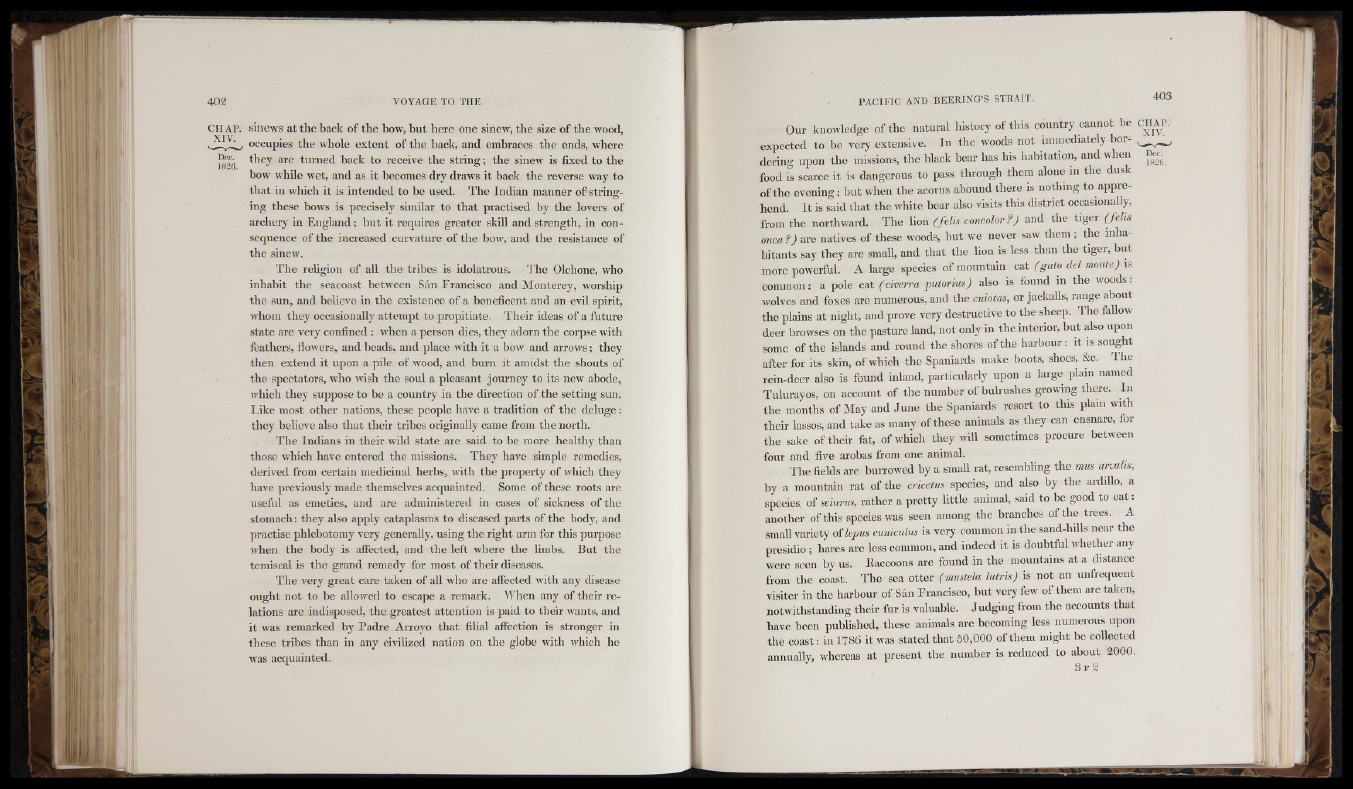
CHAP. sinews at the back of the bow, but here one sinew, tbe size of tbe wood,
XIV occupies the whole extent of the back, and embraces the ends, where
Dec.
1826.
they are turned back to receive the string ; the sinew is fixed to the
bow while wet, and as it becomes dry draws it back the reverse w'ay to
that in which it is intended to be used. The Indian manner of stringing
these bows is precisely similar to that practised by the lovers of
archery in England ; but it requires greater skill and strength, in consequence
of the increased curvature of the bow, and the resistance of
the sinew.
The religion of all the tribes is idolatrous. The Olchone, who
inhabit the seacoast between Sán Francisco and Monterey, worship
the sun, and beheve in the existence of a beneficent and an evil spirit,
whom they occasionally attempt to propitiate. Their ideas of a future
state are very confined : when a person dies, they adorn the corpse with
feathers, flowers, and beads, and place with it a bow and arrows ; they
then extend it upon a pile of w'ood, and burn it amidst the shouts of
the spectators, who wish the soul a pleasant journey to its new abode,
which they suppose to be a country in the direction of the setting sun.
Like most other nations, these people have a tradition of the deluge ;
they believe also that their tribes originally came from the north.
The Indians in their wild state are said to be more healthy than
those which have entered the missions. They have simple remedies,
derived from certain medicinal herbs, with the property of which they
have previously made themselves acquainted. Some of these roots are
useful as emetics, and are administered in cases of sickness of the
stomach ; they also apply cataplasms to diseased parts of the body, and
practise phlebotomy very generally, using the right arm for this purpose
when the body is affected, and the left where the limbs. But the
temiscal is the grand remedy for most of their diseases.
The very great care taken of all who are affected with any disease
ought not to be allowed to escape a remark. When any of their relations
are indisposed, the greatest attention is paid to their wants, and
it was remarked by Padre Arroyo that filial affection is stronger in
these tribes than in any civilized nation on the globe with which he
was acquainted.
I J t j i
Our knowledge of the natural history of this country cannot be COAP.
expected to be very extensive. In the woods not immediately bor-
deling upon the missions, the black bear has his habitation, and when Dere
food is scarce it is dangerous to pass through them alone in the dusk
of the evening; but when the acorns abound there is nothing to apprehend.
It is said that the white bear also visits this district occasionally,
from the northward. The lion ( fd is concolor f ) and the tiger ( jelis
oncu ?; are natives of these woods, but w'e never saw them ; the inhabitants
say they are smaU, and that the lion is less than the tiger, but
more powerful. A large species of mountain cat (gato del monte) is
common: a pole cat ( viverra piitorkis) also is found in the woods:
wolves and foxes are numerous, and the cuiotas, or jackaUs, range about
the plains at night, and prove very destructive to the sheep. The fallow
deer browses on the pasture land, not only in the interior, but also upon
some of the islands and round the shores of the harbour; it is sought
after for its skin, of which the Spaniards make boots, shoes, &c. The
rein-deer also is found inland, particularly upon a large plain named
Tulurayos, on account of the number of bulrushes growing there. In
the months of May and June the Spaniards resort to this plain mth
their lassos, and take as many ofthese animals as they can ensnare, for
the sake of their fat, of w’hich they wiU sometimes procure between
four and five arobas from one animal.
The fields are burrowed by a small rat, resembling the mus arvalis,
by a mountain rat of the cricetus species, and also by the ardillo, a
species, of sciurus, rather a pretty little animal, said to be good to e a t:
another of this species was seen among the branches of the trees. A
small variety oilepus cuniculus is very common in the sand-hills near the
presidio ; hares are less common, and indeed it is doubtful whether any
were seen by us. Raccoons are found in the mountains at a distance
from the coast. The sea otter (mustela lutris) is not an unfrequent
visiter in the harbour of Sán Francisco, but very few of them are taken,
notwithstanding their fur is valuable. Judging from the accounts that
have been published, these animals are becoming less numerous upon
the coast: in 1786 it was stated that 50,000 of them might be collected
annually, whereas at present the number is reduced to about 2000.
3 f 2
ii